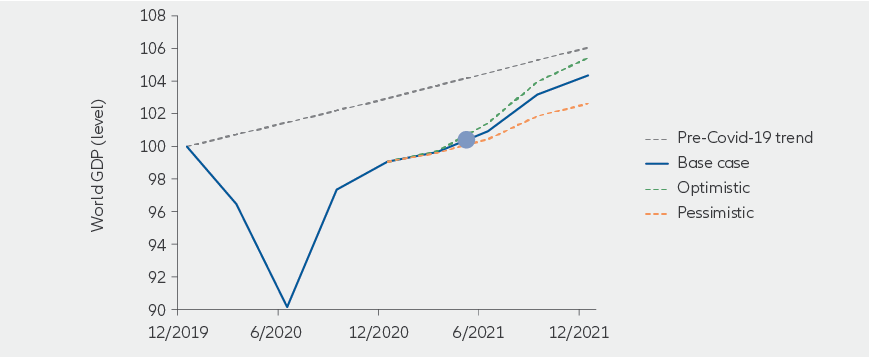2021 mid-year outlook

Summary
The economic outlook is positive at the mid-year point, thanks in large part to the significant economic stimulus packages over the past year, but all this growth may come at a price.
Active is: Making complexity investable
A roadmap for the years ahead: Introducing our investable themes

Summary
To help investors navigate today’s drastically different world, we’ve identified three overarching themes: a resurgent China, persistently low yields, and the drive to live and invest more sustainably. We’re using our expertise and insights to explain why these themes represent some of the biggest opportunities and risks for portfolios – and what investors can do.
Key takeaways
|
What’s ahead for the rest of 2021?
Overall, economic growth has returned forcefully after last year’s severe pandemic-related slowdown, bringing a boost to capital markets – though growth will likely remain below the pre-pandemic growth trend for years (see chart). While the Covid-19 crisis isn’t over, vaccines are helping some parts of the world turn the corner and the hope is that pandemic risks will decrease as the year progresses. This boom in the economy and markets comes at a potential price – not least a rise in inflation. Investors will also need to navigate uneven levels of economic growth across countries and sectors. And with diverging amounts of fiscal and monetary stimulus around the world, policymakers are responding in a way that investors will want to factor into their strategies.
Investment implications
- A spike in inflation this year – and potentially beyond – makes it important to preserve purchasing power with additional sources of return.
- The recent jump in inflation was a major factor behind the US Federal Reserve’s decision to implement small rate hikes in 2023. The market has also been expecting the Fed to start “tapering” its bond-buying, probably in 2022. Both these moves could trigger some volatility depending on how they are managed by the Fed.
- We still have a bias for risk assets – albeit with some caution. As such, we don’t think investors should “de-risk” their portfolios, but rather consider a more neutral position along the risk/return spectrum – at least for the short term.
GDP forecast (2020-2021)

Source: Bloomberg, Allianz Global Investors. Data as at May 2021.
Listen to Head of Global Economics and Strategy Stefan Hofrichter discuss our mid-year global economic outlook, including his views on growth, inflation, productivity, labor shortages, supply issues, demographics and more. Also: Stefan contextualizes his forecasts in terms of portfolio positioning and available opportunities in the current fluid environment.
Our 2021 mid-year regional outlooks
Multiple factors have boosted the economy and corporate earnings – including the successful vaccine rollout, a decline in Covid-19 cases, low interest rates and ongoing fiscal stimulus. But rising inflationary pressures and potential tax increases could turn into headwinds in the second half of the year.
Although financial markets have done well in 2021, we expect bouts of volatility throughout the year. The markets could have an ongoing bias towards value and cyclical sectors. Financials could benefit from a higher yield/steeper yield-curve environment, while energy and commodities should continue to perform as the global economy reopens. Parts of infrastructure, clean energy and 5G are all supported by President Joe Biden’s policy agenda.
Given strong growth and rising inflation, yields may continue to grind higher. This may put more downward pressure on long-duration assets/sectors, including investment-grade corporate bonds and sectors such as growth and technology.
After a weak start to the year, economic activity has moved up a gear. A strong and broad-based rebound is possible once virus-containment measures are eased more markedly and private consumption picks up. Inflation looks set to peak in 2021 before moderating in 2022. Any economic recovery will continue to depend on economic policy support, and the European Central Bank’s monetary policy remains accommodative overall.
Amid continued pandemic-inspired uncertainty, accelerating growth should help corporate earnings – which will likely be the main driver of equity returns in 2021. Although we expect longer-term government bond yields to rise moderately, led by the US, rising inflation may be temporary and the overall low-yield environment should remain intact.
We expect the economy to continue to rebound thanks to a swift vaccine rollout and the broader reopening. This will enable a catch-up in consumer spending – unleashing the high levels of household savings accumulated during the pandemic. Fiscal policy should remain supportive even as post-pandemic stimulus fades towards the end of the year. Inflation is expected to rise during the second half, but underlying cost pressures are mounting only gradually.
Post-Brexit trade frictions (particularly non-tariff barriers) continue to weigh on exports, despite the EU trade deal agreed at the end of 2020. There is little definitive evidence yet that the slump in trade with the EU will be offset by stronger trade with the rest of the world.
Thanks to effective containment of Covid-19, China’s economy has largely returned to its trend growth rate. Fiscal and monetary policy support have begun to normalise, which could be less helpful for risky assets, but China’s authorities will remain vigilant to prevent any issues from arising. Strained relations with the US may yet have an impact on the outlook for China’s trade and finances.
The recent pullback in China’s equity markets should be viewed as a healthy development, bringing valuations to more attractive levels. China’s fixed-income markets also offer investors the kind of yields that are hard to find in other major economies, where rates could remain lower for even longer. Still, China’s markets are volatile, so investors should keep a long-term perspective.
Despite a recent rise in new Covid-19 cases, Japan has begun its vaccination programme and the delayed Olympic games are scheduled to take place in Tokyo this summer. Against this backdrop, we expect domestic demand to recover gradually during the second half. Meanwhile, Japan’s external demand (the sum of exports minus imports) looks set to remain firm thanks to a continued recovery in global capital expenditures.
Price pressures remain muted despite an improved growth outlook, so the Bank of Japan has sought to make its monetary policy framework more sustainable.
The global economic recovery and modestly weaker US dollar are helpful conditions for most emerging markets. Some EM central banks have already begun to tighten – including in Turkey, Brazil and Russia -- and the expected increase in inflation may lead even more to do the same.
The threat of a renewed pickup in Covid-19 infections is particularly acute in emerging markets. While their progress in tackling the pandemic continues to lag developed markets, they are set to make more progress on this score towards the end of 2021. We continue to expect the recovery in emerging markets to be both fragile and unevenly spread. Generally, those countries that have been most successful in containing the pandemic – such as South Korea and Singapore – look to be best positioned.
-
12022: The growth opportunity of the century, PwC
Investing involves risk. The value of an investment and the income from it will fluctuate and investors may not get back the principal invested. Equities have tended to be volatile, and do not offer a fixed rate of return. Investing in the bond market is subject to risks, including market, interest rate, issuer, credit, inflation risk, and liquidity risk. The value of most bonds and bond strategies are impacted by changes in interest rates. Bond prices will normally decline as interest rates rise. The impact may be greater with longer-duration bonds. Credit risk reflects the issuer’s ability to make timely payments of interest or principal—the lower the rating, the higher the risk of default. Emerging markets may be more volatile, less liquid, less transparent, and subject to less oversight, and values may fluctuate with currency exchange rates. Investments in alternative assets presents the opportunity for significant losses including losses which exceed the initial amount invested. Some investments in alternative assets have experienced periods of extreme volatility and in general, are not suitable for all investors. Environmental, Social and Governance (ESG) strategies consider factors beyond traditional financial information to select securities or eliminate exposure which could result in relative investment performance deviating from other strategies or broad market benchmarks. Past performance is not indicative of future performance. This is a marketing communication. It is for informational purposes only. This document does not constitute investment advice or a recommendation to buy, sell or hold any security and shall not be deemed an offer to sell or a solicitation of an offer to buy any security.
The views and opinions expressed herein, which are subject to change without notice, are those of the issuer or its affiliated companies at the time of publication. Certain data used are derived from various sources believed to be reliable, but the accuracy or completeness of the data is not guaranteed and no liability is assumed for any direct or consequential losses arising from their use. The duplication, publication, extraction or transmission of the contents, irrespective of the form, is not permitted.
This material has not been reviewed by any regulatory authorities. In mainland China, it is used only as supporting material to the offshore investment products offered by commercial banks under the Qualified Domestic Institutional Investors scheme pursuant to applicable rules and regulations. This document does not constitute a public offer by virtue of Act Number 26.831 of the Argentine Republic and General Resolution No. 622/2013 of the NSC. This communication's sole purpose is to inform and does not under any circumstance constitute promotion or publicity of Allianz Global Investors products and/or services in Colombia or to Colombian residents pursuant to part 4 of Decree 2555 of 2010. This communication does not in any way aim to directly or indirectly initiate the purchase of a product or the provision of a service offered by Allianz Global Investors. Via reception of his document, each resident in Colombia acknowledges and accepts to have contacted Allianz Global Investors via their own initiative and that the communication under no circumstances does not arise from any promotional or marketing activities carried out by Allianz Global Investors. Colombian residents accept that accessing any type of social network page of Allianz Global Investors is done under their own responsibility and initiative and are aware that they may access specific information on the products and services of Allianz Global Investors. This communication is strictly private and confidential and may not be reproduced. This communication does not constitute a public offer of securities in Colombia pursuant to the public offer regulation set forth in Decree 2555 of 2010. This communication and the information provided herein should not be considered a solicitation or an offer by Allianz Global Investors or its affiliates to provide any financial products in Brazil, Panama, Peru, and Uruguay. In Australia, this material is presented by Allianz Global Investors Asia Pacific Limited (“AllianzGI AP”) and is intended for the use of investment consultants and other institutional/professional investors only, and is not directed to the public or individual retail investors. AllianzGI AP is not licensed to provide financial services to retail clients in Australia. AllianzGI AP (Australian Registered Body Number 160 464 200) is exempt from the requirement to hold an Australian Foreign Financial Service License under the Corporations Act 2001 (Cth) pursuant to ASIC Class Order (CO 03/1103) with respect to the provision of financial services to wholesale clients only. AllianzGI AP is licensed and regulated by Hong Kong Securities and Futures Commission under Hong Kong laws, which differ from Australian laws.
This document is being distributed by the following Allianz Global Investors companies: Allianz Global Investors U.S. LLC, an investment adviser registered with the U.S. Securities and Exchange Commission; Allianz Global Investors Distributors LLC, distributor registered with FINRA, is affiliated with Allianz Global Investors U.S. LLC; Allianz Global Investors GmbH, an investment company in Germany, authorized by the German Bundesanstalt für Finanzdienstleistungsaufsicht (BaFin); Allianz Global Investors (Schweiz) AG; Allianz Global Investors Asia Pacific Ltd., licensed by the Hong Kong Securities and Futures Commission; Allianz Global Investors Singapore Ltd., regulated by the Monetary Authority of Singapore [Company Registration No. 199907169Z]; Allianz Global Investors Japan Co., Ltd., registered in Japan as a Financial Instruments Business Operator [Registered No. The Director of Kanto Local Finance Bureau (Financial Instruments Business Operator), No. 424, Member of Japan Investment Advisers Association and Investment Trust Association, Japan]; and Allianz Global Investors Taiwan Ltd., licensed by Financial Supervisory Commission in Taiwan.
1678209





